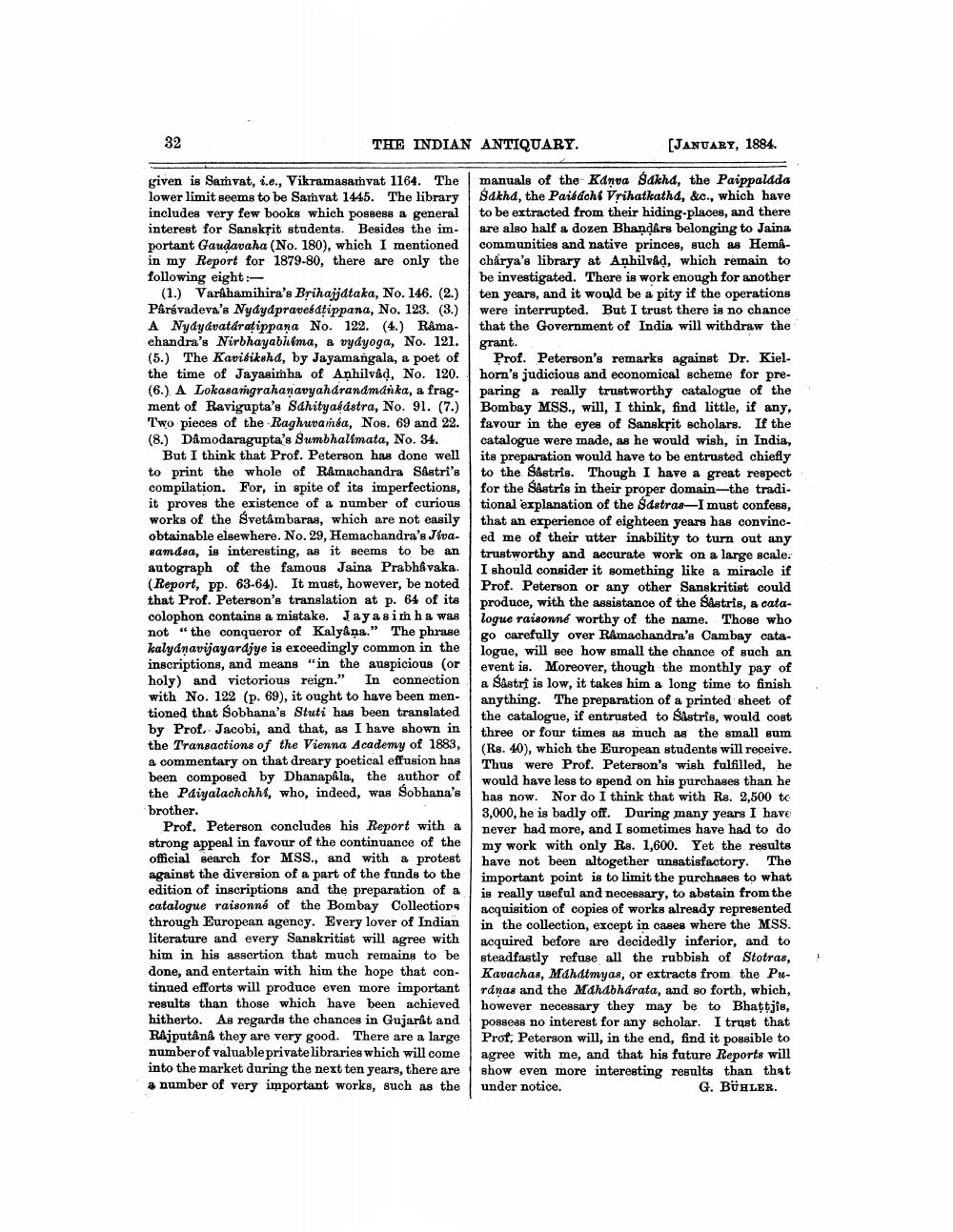________________
32
THE INDIAN ANTIQUARY.
given is Samvat, i.e., Vikramasamvat 1164. The lower limit seems to be Samvat 1445. The library includes very few books which possess a general interest for Sanskrit students. Besides the important Gauḍavaha (No. 180), which I mentioned in my Report for 1879-80, there are only the following eight:
(1.) Varâhamihira's Brihajjátaka, No. 146. (2.) Pârévadeva's Nyáydpraveśátippana, No. 123. (3.) A Nydyávatáraṭippana No. 122. (4.) Ramachandra's Nirbhayabhima, a vyayoga, No. 121. (5.) The Kaviéikshd, by Jayamangala, a poet of the time of Jayasimha of Anhilvâd, No. 120. (6.) A Lokasamgrahanavyaharanámánka, a fragment of Ravigupta's Sahityasástra, No. 91. (7.) Two pieces of the Raghuvamsa, Nos. 69 and 22. (8.) Damodaragupta's Sumbhalimata, No. 34.
But I think that Prof. Peterson has done well to print the whole of Ramachandra Sâstrî's compilation. For, in spite of its imperfections, it proves the existence of a number of curious works of the Svetâmbaras, which are not easily obtainable elsewhere. No. 29, Hemachandra's Jivasamdea, is interesting, as it seems to be an autograph of the famous Jaina Prabhavaka. (Report, pp. 63-64). It must, however, be noted that Prof. Peterson's translation at p. 64 of its colophon contains a mistake. Jayasimha was not "the conqueror of Kalyana." The phrase kalyanavijayardjye is exceedingly common in the inscriptions, and means "in the auspicious (or holy) and victorious reign." In connection with No. 122 (p. 69), it ought to have been mentioned that Sobhana's Stuti has been translated by Prof. Jacobi, and that, as I have shown in the Transactions of the Vienna Academy of 1883, a commentary on that dreary poetical effusion has been composed by Dhanapâla, the author of the Paiyalachchht, who, indeed, was Sobhana's
[JANUARY, 1884.
manuals of the Kanva Sakhd, the Paippaláda Sakhd, the Paisachi Vrihatkatha, &c., which have to be extracted from their hiding-places, and there are also half a dozen Bhandars belonging to Jaina communities and native princes, such as Hemâcharya's library at Anhilvâd, which remain to be investigated. There is work enough for another ten years, and it would be a pity if the operations were interrupted. But I trust there is no chance that the Government of India will withdraw the grant.
brother.
Prof. Peterson concludes his Report with a strong appeal in favour of the continuance of the official search for MSS., and with a protest against the diversion of a part of the funds to the edition of inscriptions and the preparation of a catalogue raisonné of the Bombay Collections through European agency. Every lover of Indian literature and every Sanskritist will agree with him in his assertion that much remains to be done, and entertain with him the hope that continued efforts will produce even more important results than those which have been achieved hitherto. As regards the chances in Gujarât and Rajputânâ they are very good. There are a large number of valuable private libraries which will come into the market during the next ten years, there are a number of very important works, such as the
Prof. Peterson's remarks against Dr. Kielhorn's judicious and economical scheme for preparing a really trustworthy catalogue of the Bombay MSS., will, I think, find little, if any, favour in the eyes of Sanskrit scholars. If the catalogue were made, as he would wish, in India, its preparation would have to be entrusted chiefly to the Sastris. Though I have a great respect for the Sâstris in their proper domain-the traditional explanation of the Sastras-I must confess, that an experience of eighteen years has convinced me of their utter inability to turn out any trustworthy and accurate work on a large scale. I should consider it something like a miracle if Prof. Peterson or any other Sanskritist could produce, with the assistance of the Sâstris, a catalogue raisonné worthy of the name. Those who go carefully over Ramachandra's Cambay catalogue, will see how small the chance of such an event is. Moreover, though the monthly pay of a Śâstri is low, it takes him a long time to finish anything. The preparation of a printed sheet of the catalogue, if entrusted to Sastris, would cost three or four times as much as the small sum (Rs. 40), which the European students will receive. Thus were Prof. Peterson's wish fulfilled, he would have less to spend on his purchases than he has now. Nor do I think that with Rs. 2,500 to 3,000, he is badly off. During many years I have never had more, and I sometimes have had to do my work with only Rs. 1,600. Yet the results have not been altogether unsatisfactory. The important point is to limit the purchases to what is really useful and necessary, to abstain from the acquisition of copies of works already represented in the collection, except in cases where the MSS. acquired before are decidedly inferior, and to steadfastly refuse all the rubbish of Stotras, Kavachas, Mahatmyas, or extracts from the Puránas and the Mahabharata, and so forth, which, however necessary they may be to Bhaṭṭjis, possess no interest for any scholar. I trust that Prof, Peterson will, in the end, find it possible to agree with me, and that his future Reports will show even more interesting results than that under notice. G. BÜHLER.




